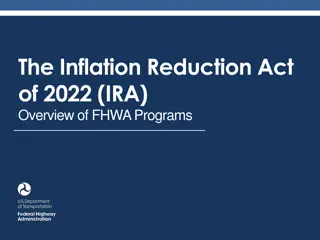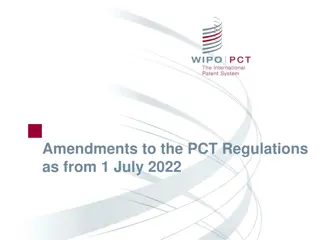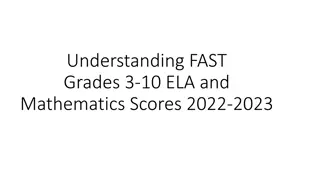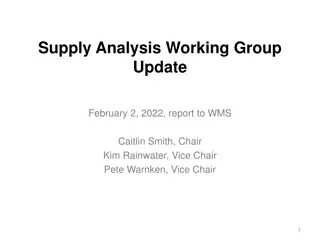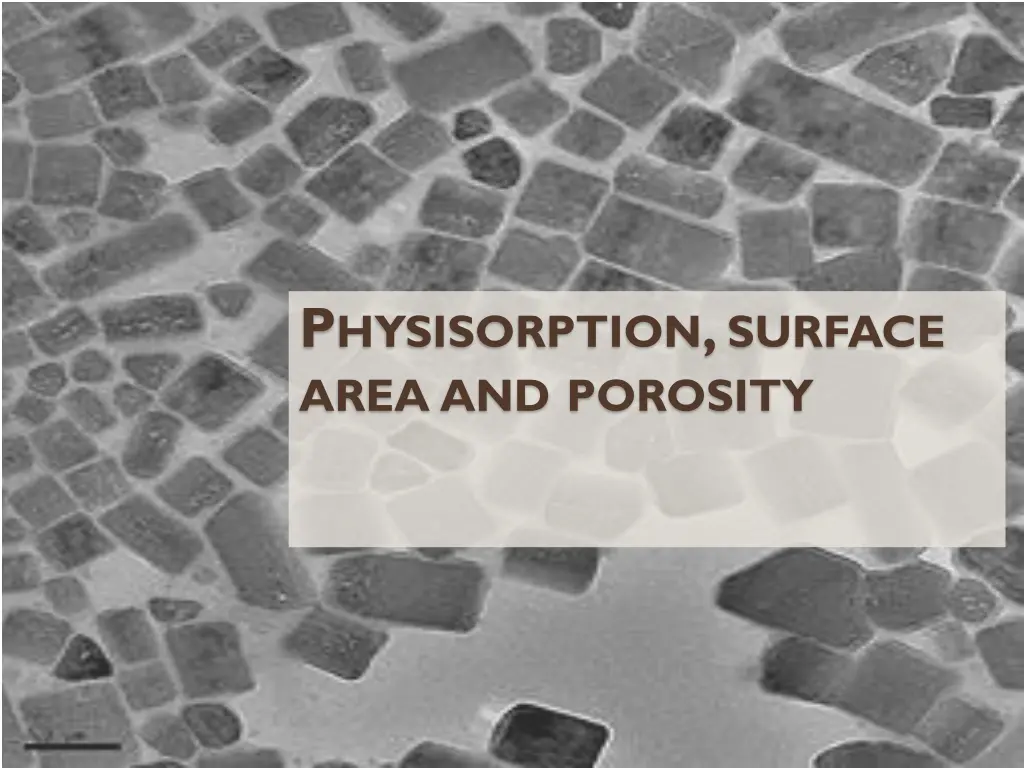
Understanding Adsorption and Surface Reactions
Explore the concepts of physisorption, chemisorption, and different types of pores in the context of adsorption and surface reactions. Learn about the surface area, porosity, and the characteristics of various adsorption isotherms. Understand the differences between weak van der Waals interactions and strong chemical bonding, and how they influence adsorption behavior on different surfaces.
Download Presentation

Please find below an Image/Link to download the presentation.
The content on the website is provided AS IS for your information and personal use only. It may not be sold, licensed, or shared on other websites without obtaining consent from the author. If you encounter any issues during the download, it is possible that the publisher has removed the file from their server.
You are allowed to download the files provided on this website for personal or commercial use, subject to the condition that they are used lawfully. All files are the property of their respective owners.
The content on the website is provided AS IS for your information and personal use only. It may not be sold, licensed, or shared on other websites without obtaining consent from the author.
E N D
Presentation Transcript
PHYSISORPTION, SURFACE AREA AND POROSITY
100 Kg H2O V = 100 L V = a3= 100 dm3a = 4.64 dm Surface 6 x a2 = 129dm2 1 cube 100 Kg H2O Vi= 1 L Vi= ai Total surface 100 x 6 x ai = 600dm2 3= 1 dm3a = 1 dm 2 100 cubes
Adsorption and Reaction at Surfaces PHYSISORPTION CHEMISORPTION WEAK, LONG RANGE BONDING Van der Waals interactions (e.g. London dispersion, dipole-dipole).. STRONG, SHORT RANGE BONDING Chemical bonding involving orbital overlap and charge transfer. NOT SURFACE SPECIFIC Physisorption takes place between all molecules on any surface providing the temperature is low enough. SURFACE SPECIFIC Marked variation between crystal planes E.g. Chemisorption of hydrogen takes place on transition metals but not on gold or mercury. ads= 50 .. 500 kJ mol-1 Wide range (related to the chemical bond strength) ads= 5 .. 50 kJ mol-1 Related to factors like molecular mass and polarity (i.e. ~ heat of liquefaction) Non activated with equilibrium achieved relatively quickly. Increasing temperature always reduces surface coverage. Can be activated, in which case equilibrium can be slow and increasing temperature can favour adsorption. No surface reactions. Surface reactions may take place:- Dissociation, reconstruction, catalysis. MULTILAYER ADSORPTION BET Isotherm used to model adsorption equilibrium. MONOLAYER ADSORPTION Langmuir Isotherm used to model adsorption equilibrium..
Type I Pores are typically microporus with the exposed surface residing almost exclusively inside the microspores, which once filled with adsorbate, leave little or no external surface for further adsorption. Type II Most frequently found when adsorption occurs on nonporous powders or powders with diameters exceeding micropores. Inflection point occurs near the completion of the first adsorbed monolayer. Type III Characterised by heats of adsorption less than the adsorbate heat of liquification, adsorption proceeds as the adsorbate interaction with an adsorbed layer is greater than the interaction with the adsorbent surface. Type IV Occur on porous adsorbents with pores in the range of 2 100nm. At higher pressures the slope shows increased uptake of adsorbate as pores become filled, inflection point typically occurs near completion of the first monolayer Type V Are observed where there is small adsorbate-absorbent interaction potentials (similar to type III), and are also associated with pores in the 2 100 nm range. Type VI The reversible stepwise Type VI isotherm is representative of layer-by-layer adsorption on a highly uniform nonporous surface. 3
IUPAC Classification Macroporous > 50nm Mesoporus 2-50 nm Microporus < 2nm 8
Where... Pv Psat H Vl R T = equilibrium vapor pressure = saturation vapor pressure = mean curvature of meniscus = liquid/vapor surface tension = liquid molar volume = ideal gas constant = temperature 8
Adsorption Kinetic behavior of the adsorption process Rate of arrival of adsorption is equal to the rate of desorption Heat of adsorption was taken to be constant and unchanging with the degree of coverage, 9
Langmuir Assumption Gas molecules behave ideally Only 1 monolayer forms All sites on the surface are equal No adsorbate-adsorbate interaction Adsorbate molecule is immobile 10
Langmuir Isotherm An isotherm describes the dependence of volume, concentration , or in the case of a surface, coverage , on pressure p at constant temperature T at equilibrium. = [ (p)]T In the equilibrium between the gas phase and the adsorbed phase, LeChatelier's Principle predicts that at constant temperature an increase in pressure will increase the number of molecules adsorbed on the surface since the volume occupied by the molecules at the surface (per mole) is smaller. p This can, however, reach a limiting value. The number of molecules adsorbed at any pressure p will also depend on the strength of the adsorbate bond to the surface. 11
Langmuir Isotherm Langmuir s checkerboard model of adsorption assumes that a surface is composed of a finite number of equivalent adsorption sites. So the maximum coverage is obtained when all sites are filled. The coverage is expressed in terms of the number of molecules adsorbed in relation to the number of available sites. i.e. When all sites are filled, = 1. p Consider the equilibrium: kads Agas Aadsorbed The Rate of adsorption is proportional to: The number of surface collisions n from the gas phase 1) per second, which is proportional to the pressure p . 2) area of bare surface available for adsorption (1 - ). ie. rate of adsorption = kads P (1 - ) 12
Langmuir Isotherm p Consider the equilibrium: Agas Aadsorbed kdes Rate of desorption proportional to: 1) the fraction of surface covered by adsorbate . i.e rate of desorption = kdes 13
At equilibrium = 1 Rate of adsorption = Rate of desorption b = 100 b = 50 kads p (1 - ) = kdes b = 10 If we write b = kads / kdes p = bp / (1+bp) .. The Langmuir Isotherm Since b = kads / kdes , this is the same as an equilibrium constant K And since ln K = - G/RT one can write: b = exp (- G/RT ), i.e b reflects the strength of the adsorbate bond to the surface. Since = = nads / nmax p / nads = 1 / b nmax + p / nmax 14
Langmuir Isotherm Limitations and approximations finite number of equivalent adsorption sites different surface adsorbate structures surface reconstruction 15
Langmuir Isotherm Limitations and approximations finite number of equivalent adsorption sites lateral interactions between adsorbates Enthalpy of adsorption Hads depends on site/coverage 16
Langmuir Isotherm Limitations and approximations rate of adsorption = kads p (1 - ) X assumes collision at a vacant site is required for adsorption rate of adsorption i.e. sticking probability (S) precursor kinetics S (1 - ) 17
The concept of the B.E.T. theory is an extension of the Langmuir theory, which is a theory for monolayer molecular adsorption, to multilayer adsorption with the following hypotheses 1. gas molecules physically adsorb on a solid in layers infinitely; 2. gas molecules only interact with adjacent layers; and 3. the Langmuir theory can be applied to each layer. 4. the enthalpy of adsorption for the first layer is constant and greater than the second (and higher). 5. the enthalpy of adsorption for the second (and higher) layers is the same as the enthalpy of liquefaction. 18
Physisorption Brunauer, Emmett and Teller BET Theory * Multilayer adsorption oFraction of surface unoccupied A1condensation coefficient (adsorption probability) * Dynamic equilibrium Nm monolayer n of molecules in a = rateads kP 0A 1. 1 E1Energy of adsorption adsorbate s vibrational frequency = 1 / E RT rate N e 1 2. 1 des m 1 = / E RT N e kP A First layer 1 3. 1 0 1 m 2 = / E RT N e kP A 4. 2 Second layer 2 1 2 m
n = / E RT N e kP A 5. nthlayer n 1 m n n n Assuming , E and A constant for 2nd, 3rd, nthlayer (liquid state) 1 = / E RT N e kP A 1 1 0 1 m L heat of liquefaction n = / L RT 6. N e kP A 1 m n kPA = = 1 1 7. / E RT N me 1 0 1
kPA = = 1 1 7. = / E RT 11. N me 1 1 0 0 1 = = 12. kPA 2 1 0 = = 8. 2 / L RT N me = = 2 13. 1 3 2 0 kPA = = 1 n 14. = = 3 9. 1 0 n n / L RT N me 2 kPA = = n 10. m / L RT N e 1 n
The total number of molecules adsorbed at equilibrium is 15. = + + + = + + + 2 ..... ( 2 ..... ) N N N nN N n 1 2 1 2 m m m n m n Substituting for 1, 2 , N 16. from 11-14. = + + + 1 2 n 2 3 ... n 0 0 0 0 N m = + + + 2 1 n 1 ( 0 2 3 ... ) n Since and are constant 17. = C 1 A = ( / ) E L RT 2 e C 1 18. from 7-10. 2 A 1
= C Substituting in 16. N = 19. + + + 2 3 n ( 2 3 ... ) C n 0 N m C N = 0 20. 2 1 ( ) N m 1 = + + + n 21. = n 22. = + + = 1 ( .... ) 1 0 1 2 n n 1 Substituting 22 into 20 N C = n = 1 ( ) 23. n 2 1 ( ) N 1 m
nin 23. with n-1ofrom 14. Replacing N C = n 24. = 1 n 1 ( ) 0 2 1 ( ) N 1 m Replacing in 24. with C from 17. N C = n 25. = n 1 ( ) C 0 2 1 ( ) N 1 m Since 26. = n = + + + + = 1 2 n n ... 1 1 N C 27. = 1 ( ) C 0 2 1 ( ) 1 N m
From 20. 1 C N = 2 1 ( ) N 28. 0 m N C = Substituting 28 in 27. 1 ( ) C 0 2 1 ( ) 1 N m 1 = 29. 1 1 ( ) C 0 1 0 1 = 30. 0 + 1 /( 1 ) C Introducing ofrom 30. into 20 = 1 when N C N/Nm = infinite Condensation on the surface or P/P0= 1 = 31. + 1 ( )( 1 ) N C m
Considering Eq. 10 for P/P0= 1 , = 1 when kPA = = n m kP / L RT N e P 1 n = 33. A 0P 0 = 1 32. / L RT N me Introducing into 31. N 34. ( ) + C P P = o 1 ( )( 1 ( )) N P P P P C P P m o o o Recalling that N/Nm= n/nm 1 1 1 C P = + ( ) 1 n P P n C n C P o m m o
Brunauer Emmett and Teller (BET equation): 1 / 1 1 C n C m P P = + ( ) 1 n C m n P P 0 0 namount of adsorbate (g) at the pressure P nm amount of adsorbate corresponding to the formation of a monolayer C BET constant P0 saturation pressure 1 s i m= n = +1 C + 1 1 C s i = s 1 ( ) / n P P n C 0 m n N a M 1 = m a m S = i t n C w m 0.05 0.35 Mw Molecular weight of the adsorbate NaAvogadro Number am cross section area of the adsorbate. P/Po




